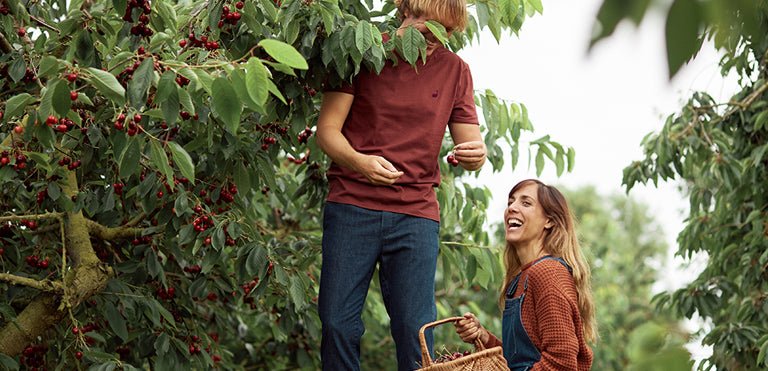Organic farms are filled with small explosions of colour. The deep red of the cherries, the purple or bright orange of the carrots among the umber of the earth. Everywhere you look, vitality beams back, with fertile land giving rise to flavorful produce. Here, you can find the roots of change.

Eating more of what grows in the ground, and less meat, is said to be the most powerful action a person can take to lower their impact on the planet. The nuances of your own carbon footprint (you can use this tool to calculate it) will play a role, but one thing is clear: being conscious of what you eat is a great step towards a sustainable lifestyle. This doesn’t mean swearing an allegiance to pea-protein for the rest of your life, it’s more about taking steps in the right direction. As research from Frontiers in Nutrition – plotted on our graph – shows, simply cutting down meat intake to 2 times a week almost cuts a person’s carbon footprint in half. An expert in the field, Joseph Poore even claimed that if every family in Britain swapped a meat-based meal for a plant-based one just once a week, it would be equivalent to taking 16 million cars off the road. Eating less meat would also help to protect our oceans.



That’s because meat-farming plays a big role in the world’s dead zones - the black holes of the ocean, where almost nothing can survive. This comes from the run-off of nutrients from fertiliser and animal waste: which work their way to the sea, promote algal blooms and remove oxygen from the water. What we choose to eat is intrinsically connected to what we love.
 The good news is that becoming flexitarian, vegetarian or vegan is not only getting easier, it’s also becoming more popular. A 2020 study found that 40% of European’s surveyed are eating less meat. The trend is towards cleaner diets that have a positive impact, on both health and environment. Even so, it’s understandable to wonder if the grass really is greener – or to be worried that the meals won’t be as fulfilling. As I’ve always been a vegetarian, it’s hard for me to say but I think instead of the shelf in my mum’s kitchen that is bending under the weight of cookery books, or her vegetarian Bolognese that is the stuff of legend among my friends, who are meat-eaters. Both would suggest that the world of meat-free cooking is nowhere near as boring or limited as first imagined.
The good news is that becoming flexitarian, vegetarian or vegan is not only getting easier, it’s also becoming more popular. A 2020 study found that 40% of European’s surveyed are eating less meat. The trend is towards cleaner diets that have a positive impact, on both health and environment. Even so, it’s understandable to wonder if the grass really is greener – or to be worried that the meals won’t be as fulfilling. As I’ve always been a vegetarian, it’s hard for me to say but I think instead of the shelf in my mum’s kitchen that is bending under the weight of cookery books, or her vegetarian Bolognese that is the stuff of legend among my friends, who are meat-eaters. Both would suggest that the world of meat-free cooking is nowhere near as boring or limited as first imagined.



To give you a flavour of this, we’re delighted to bring you just one among hundreds of original recipes from the thriving plant-based blog – Being Biotiful. The author, Chloé Sucrée, a friend of TWOTHIRDS, combines unusual ingredients to make living healthier all the more tasty, in this case with “crunch and colour”. Bon appetit!

Buckwheat Salad with Pesto, Cherries, Rocket and Roasted Zucchini
by Chloé Sucrée.
Preparation time: 20 mins.
Serves: 4.
Ingredients
- 1/2 cup / 90 gr. uncooked buckwheat
- 1 cup / 250 ml. of water pinch of salt
- 1-2 small zucchini thinly sliced
- A handful of cherries cut in two
- A handful of rocket leaves
- 8-10 kalamata olives
- 3 radishes thinly sliced
- 1 cup / 185 gr. chickpeas
- Cooked and drained pesto* see recipe here
- 1/4 cup / 40 gr. roasted and chopped almonds
- A sprinkle of chopped parsley
- optional: add fresh goat’s cheese
- A good vinaigrette
Steps:
First, cook the buckwheat in 1 cup / 250 ml. of water for 7-8 minutes, being careful not to overdo it. Drain and reserve.
Clean the zucchini and cut into thin slices. Heat a skillet with 1 tablespoon of olive or coconut oil and sauté the zucchini slices over medium heat for about 10 minutes or until they are cooked and golden. Then sauté the almonds for a few minutes.
In a large bowl, mix the buckwheat with 2 to 4 tablespoons of the pesto. Add the chickpeas, roasted zucchini, cherries, radish slices, olives, and rocket leaves. Mix well. Add the chopped parsley and goat cheese if you like.
Taste and rectify with more salt, olive oil and / or lemon juice.










